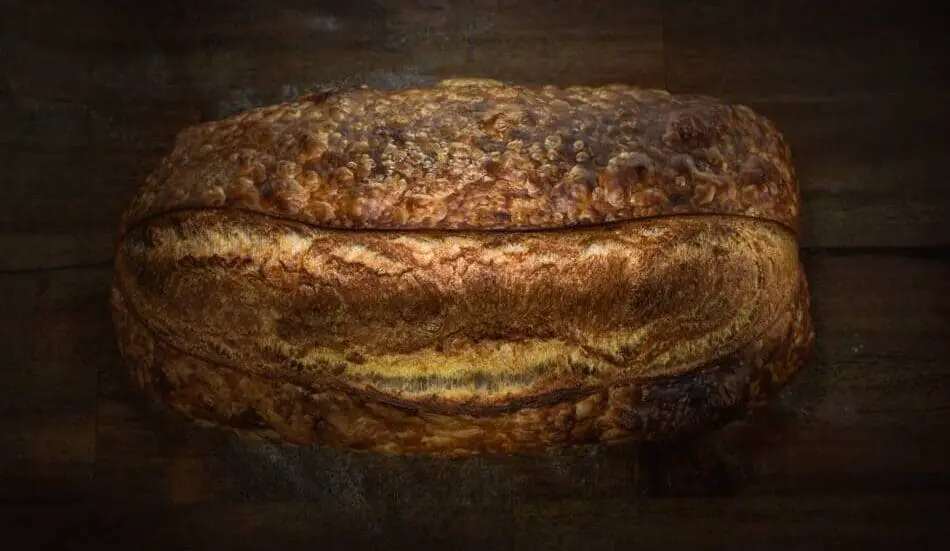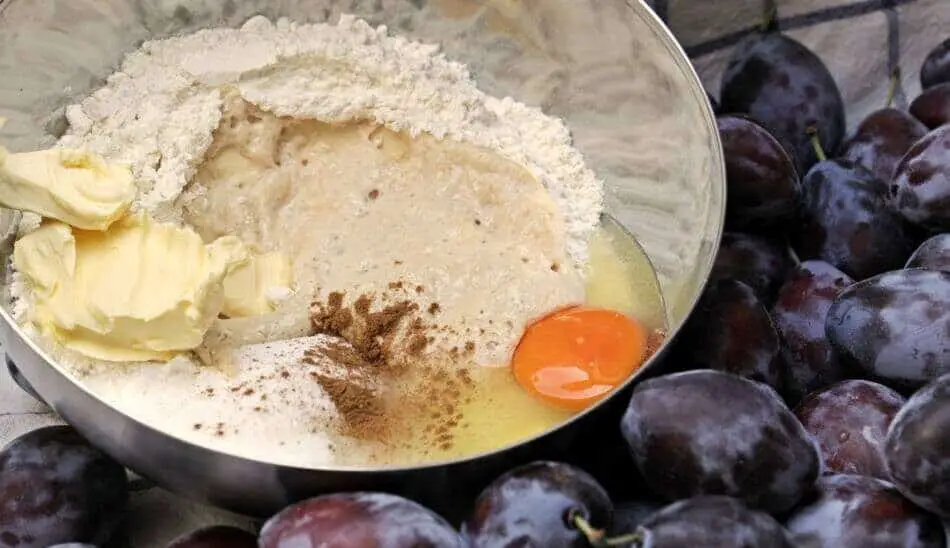Sourdough bread gets its brown coloration from the Maillard reaction when residual reducing sugars and acids in the dough reacts under the exposure of heat.
Inadequate steaming is the most common cause for lack of browning in sourdough bread. Steaming reduces the surface temperature of the dough, enabling amylase enzymes to remain active for a longer period in the oven which produces more residual sugar for browning through the Maillard reaction.
Adequate browning of the crust is important as it imparts significant amount of flavor to the baked loaf. However, care should be taken as excessive browning will lead to a bitter tasting loaf.
In other cooking applications, the Maillard reaction is also responsible for the flavorful charred surface of barbecued meat, the browning of a toasted bread, and the smokey flavor in wok fried Chinese food.
Controlling Browning by Understanding the Maillard reaction
The browning of the crust is due to a chemical reaction known as the Maillard reaction which occurs when the acids and reducing sugars in the sourdough reacts as the dough’s surface temperature exceeds 100 Celcius.
There are two aspects in the Maillard reaction we can control to vary how brown we want our sourdough bread to be; that is the amount of reducing sugars in the dough as well as the temperature of the bake.
The amount of residual reducing sugar determines the tonality of the brown coloration; the more residual reducing sugar that is present during the bake, the crust develops into a richer and deeper brown coloration.
Naturally present amylase enzymes found in flour breaks down the starches in flour into simple reducing sugars that is important for the Maillard reaction. Some of these simple sugar is consumed by yeast and bacteria in sourdough bread to undergo fermentation.
It is the amount of residual reducing sugars, or reducing sugars that are not consumed by the yeast and bacteria that is important for a more prominent Maillard reaction and browning of the crust.
The temperature of the bake controls how rapidly the crust becomes darker; the higher the baking temperature, the quicker the crust turns to a darker shade of brown.
Therefore, to get a rich dark brown crust, we need a way to maximize the amount of residual reducing sugar in the dough, while baking at an appropriate temperature so that the loaf does not darken excessively before it is fully baked.

How to get rich brown color in sourdough bread?
1. Adequate steaming
By far the best way to achieve a rich brown color in our sourdough bread is to introduce steam into our oven during the bake. Steaming lowers the surface temperature of the loaf, delaying the time of death of amylase enzymes due to heat, allowing the amylase enzymes to produce more residual reducing sugar before being deactivated and subsequently results in a richer brown coloration of the crust.
This works because yeast and bacteria dies and stops fermenting at a lower temperature than when the amylase enzymes are deactivated; bacteria and yeast dies at about 50 Celcius and 60 Celcius respectively while amylase enzymes remains active up until 90 Celcius.
Throughout the time the dough takes to get from 60 Celcius to 90 Celcius, only the amylase enzymes remain active which continues to increase the amount of residual reducing sugar in the dough without the yeast and bacteria consuming it.
Steaming prolongs the time it takes for the dough to increase in temperature from 60 Celcius to 90 Celcius, and hence increases the amount of residual reducing sugar that is important for the browning of the crust.
Steaming can be done by either baking the loaf in a sealed dutch oven, or placing a pan of water at the bottom shelf of the oven during a bake. The moisture in the loaf evaporates and provides adequate amount of steam if using the dutch oven method.
Typically when the crust has taken on the desired coloration, we vent the oven releasing all the steam for the loaf to finish baking in a dry environment which allows the crust to remain thin and crisp.
2. Extended baking time at a lower temperature
Another way of achieving a dark and brown coloration of the crust is to bake at a lower heat for a longer time.
The lower heat has similar affects as steaming, as it prolongs the time amylase enzymes remain active in the dough, as it takes a longer time for the dough to increase from 60 Celcius to 90 Celcius, increasing the amount of residual reducing sugar on the surface of the dough and hence producing a richer browning of the crust.
Since heat is lowered, the crust does not burn easily when baking time in increased. A great example of rich dark colored bread made with low heat over a long period is in the baking of the German pumpernickel rye bread.
True pumpernickel bread is made by loading the dough into the oven with tight fitting covered lids and baking it in a gentle receding heat throughout the night. Pumpernickel bread is rich brown and almost black in color.
3. Adding diastatic malt to your flour
The presence of sufficient amylase enzymes in our flour is very important for the rich browning of the crust. Without enough amylase enzymes, there isn’t enough residual sugar available at the time of the bake for the Maillard reaction to occur and hence the resulting baked loaf will be pale and dull in color.
Some flour that is milled has too little amylase enzymes and this can be determined through the falling number of the flour. The higher the falling number, the lesser the amount of amylase enzymes that is available in the flour. When falling number is more than 300, we need to increase the amount of amylase enzyme in the flour.
Try steaming and baking at a lower temperature first, and if those method does not work, then it is probably a deficiency of amylase enzyme in the flour that is preventing the baked loaf from browning.
We can increase the amount of amylase enzyme in the flour by adding diastatic malt at 0.1% to 0.2% of total flour weight. If malted barley is listed as a part of the ingredient in the flour, the flour has been corrected and no additional diastatic malt is required.

4. Using fats,oil and sugary products
The addition of fats, oil and sugary products in sourdough bread helps the crust to achieve a darker coloration quicker. This method however does not produce the deep rich brown color of baked loaf made without these additional ingredients.
Fats and oil (vegetable oil, butter, egg wash) functions to increase the thermal conductivity of the loaf, the surface of the loaf rises in temperature much more quickly from the presence of fats and oil, and speeds up the Maillard reaction resulting in a darker crust in a shorter time.
Sugary products (honey, milk) increase the sugar content of the dough, which contributes to the Maillard reaction and the browning of the crust.
If the sourdough bread starts to darken too quickly, lower the temperature by 5-10 Celcius for the rest of the bake.
Conclusion
The recommended technique to achieve a richer brown coloration of your sourdough bread is to provide adequate steaming and baking at a lower temperature across a longer time. This two method prolongs the time amylase enzymes remains active, increasing the amount of residual sugar in the dough, and hence contributing significantly to the browning of the crust.
Alternatively you can introduce some fat, oil or sugary ingredient into the formula to help the loaf darken.
Lower oven temperature by 5-10 Celcius if the crust is taking on too much coloration too quickly.

